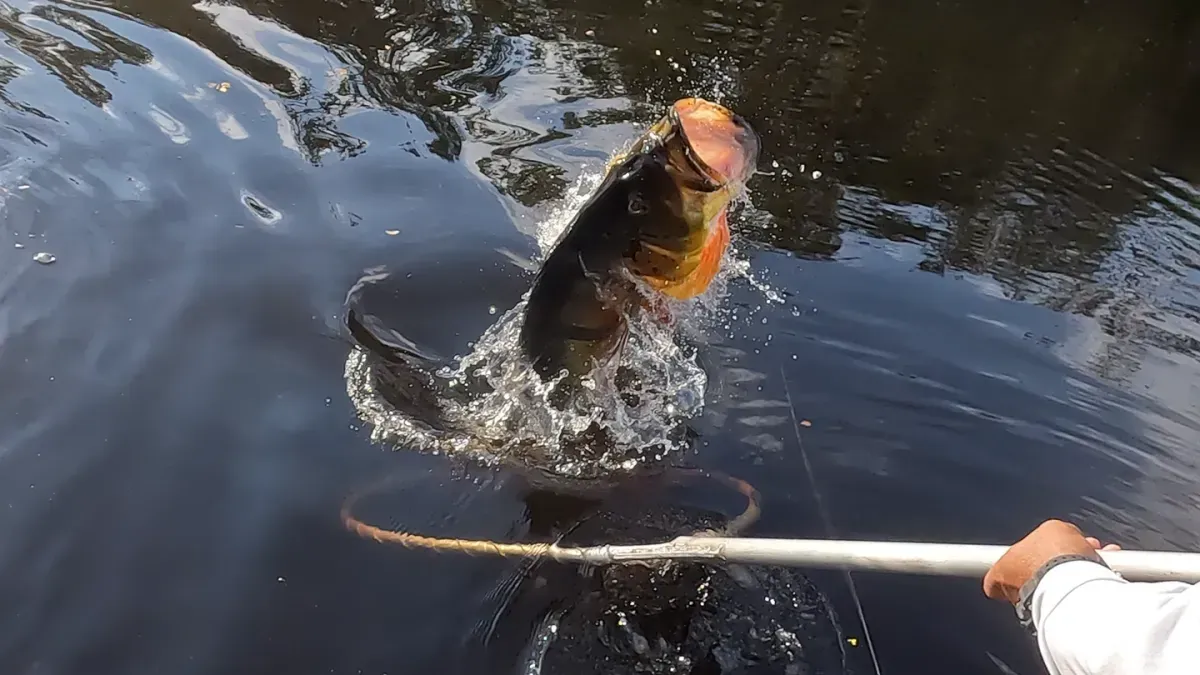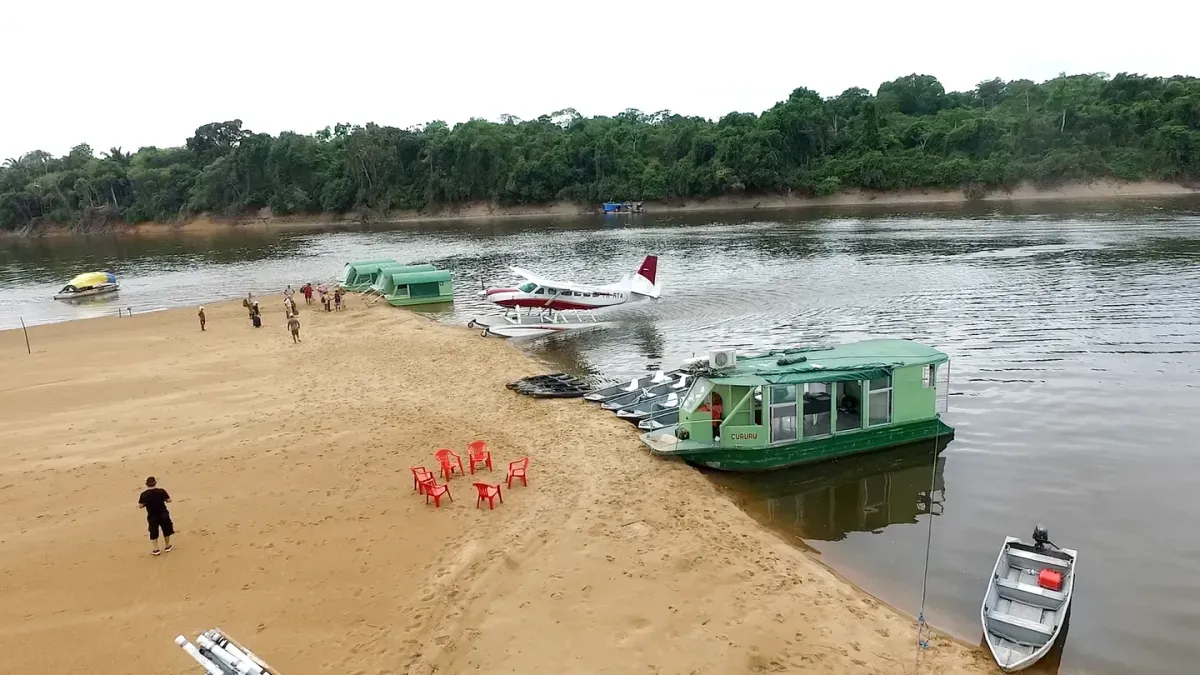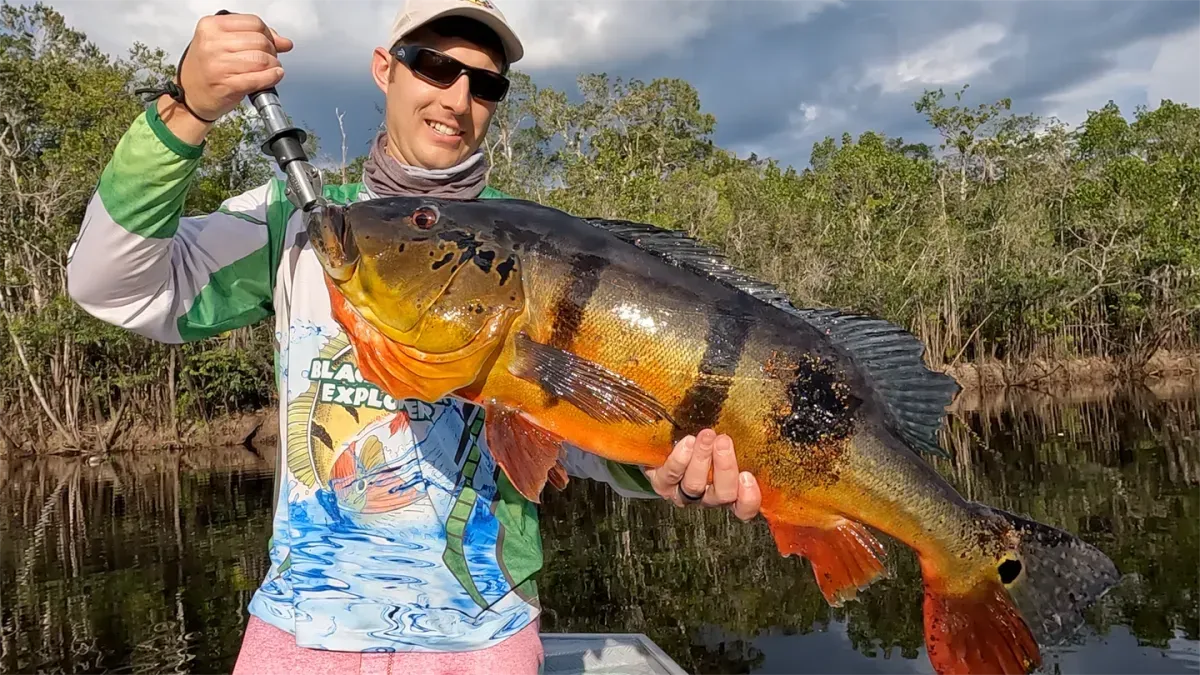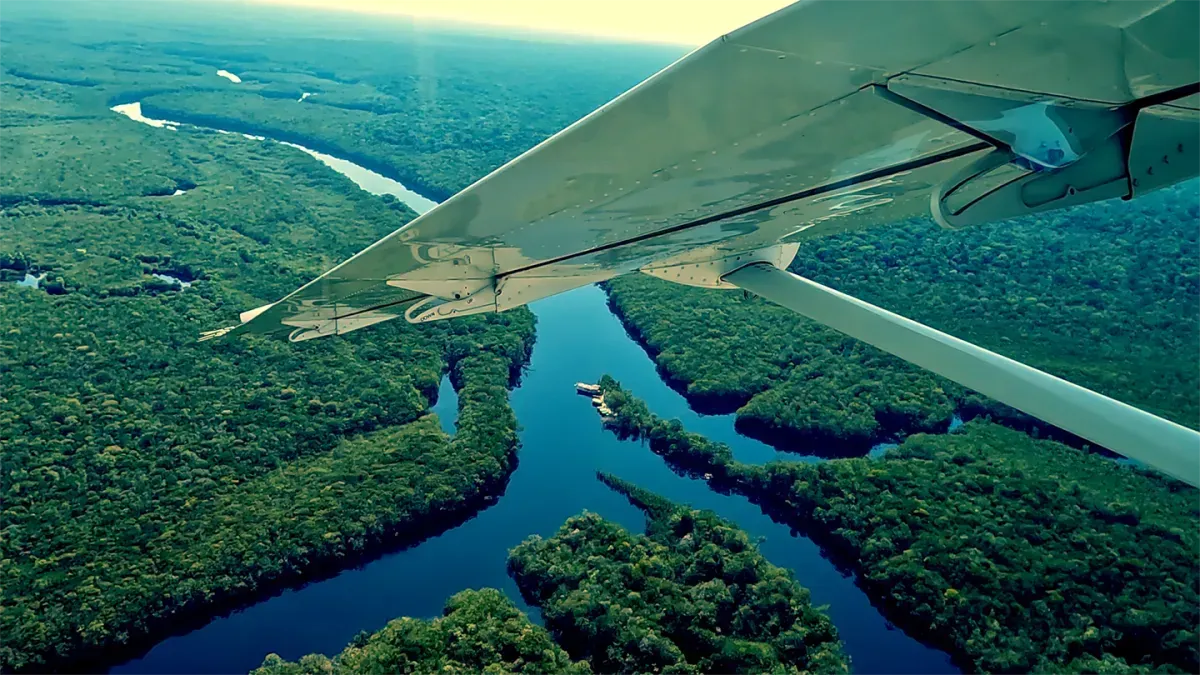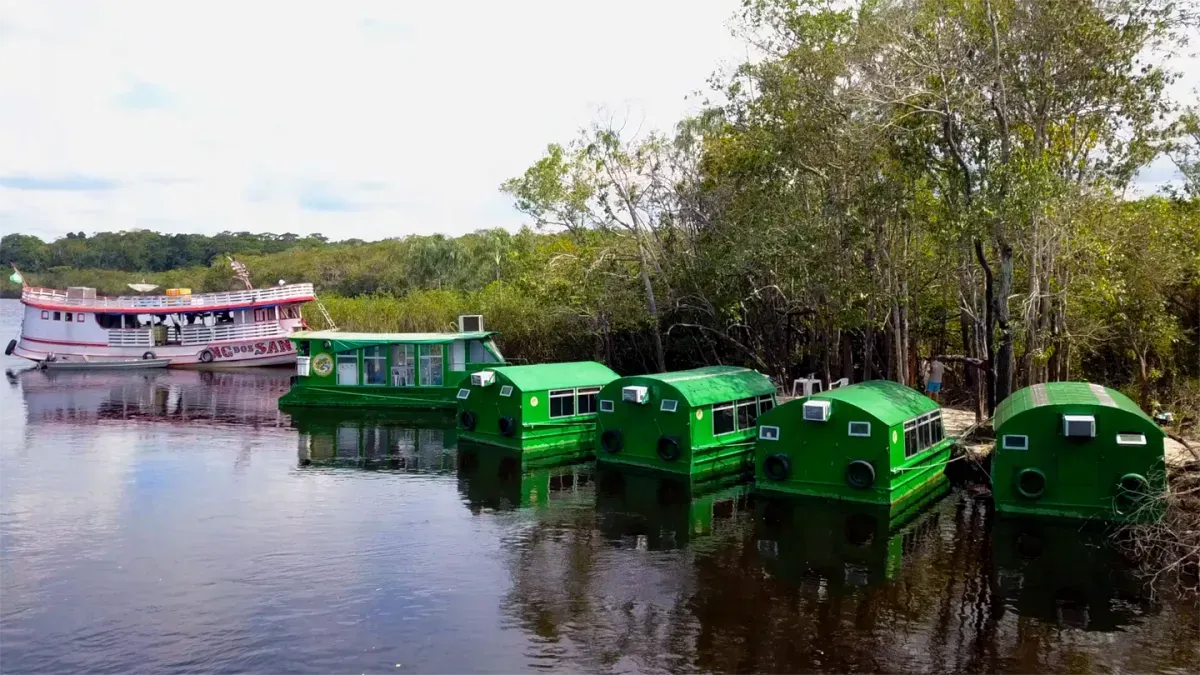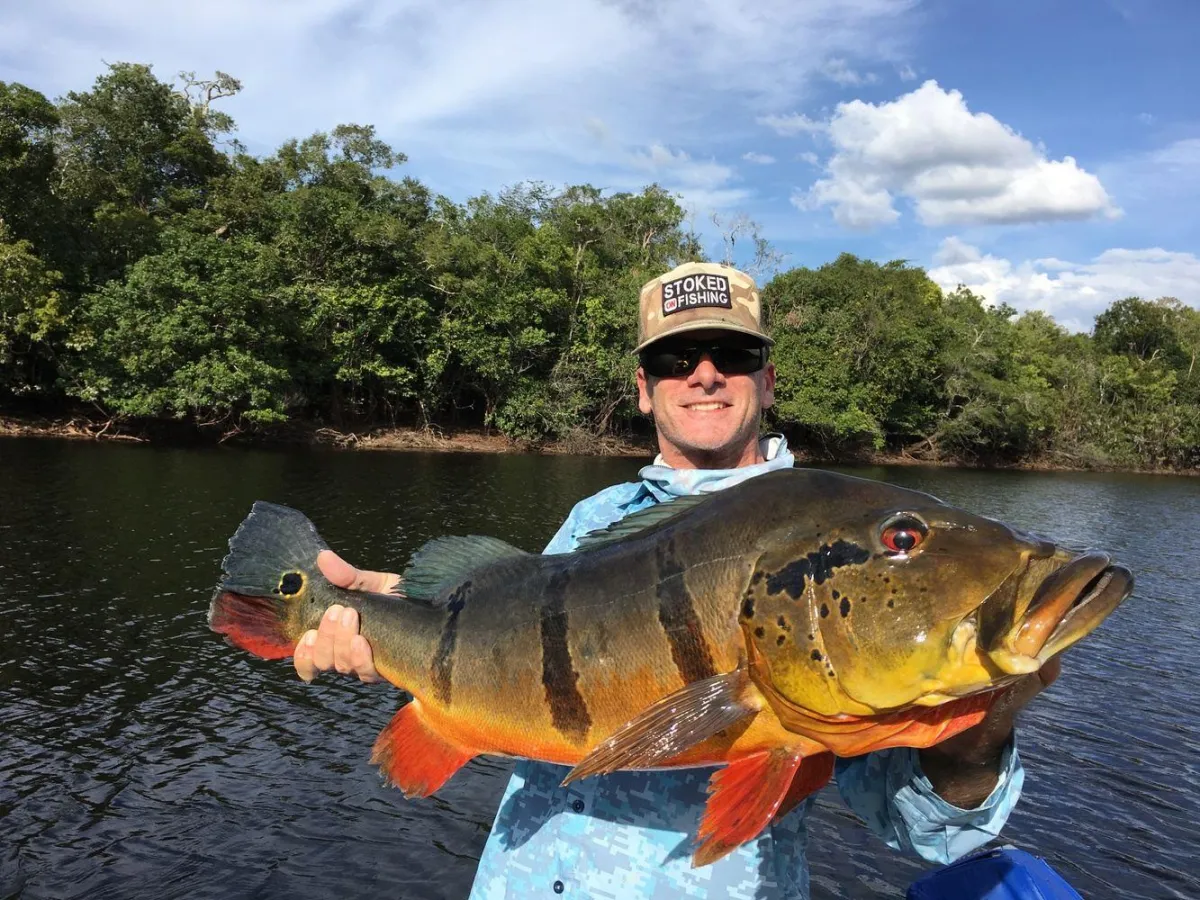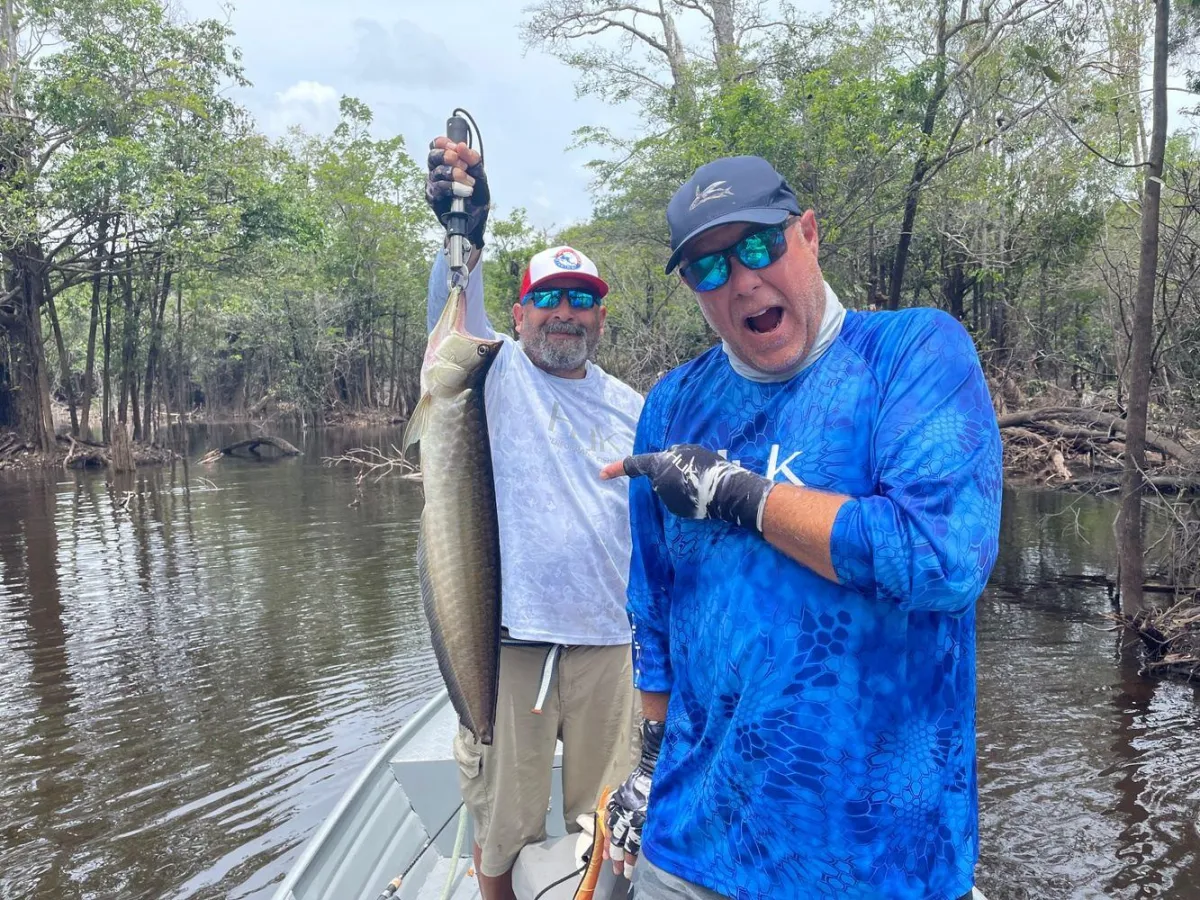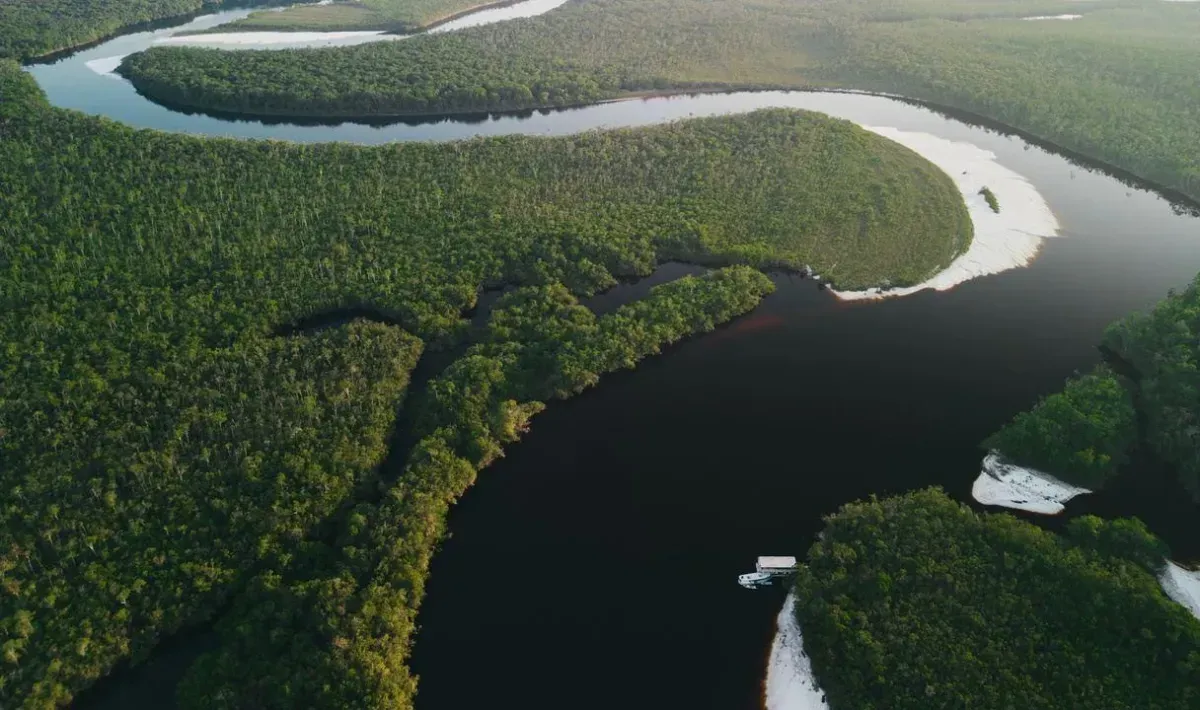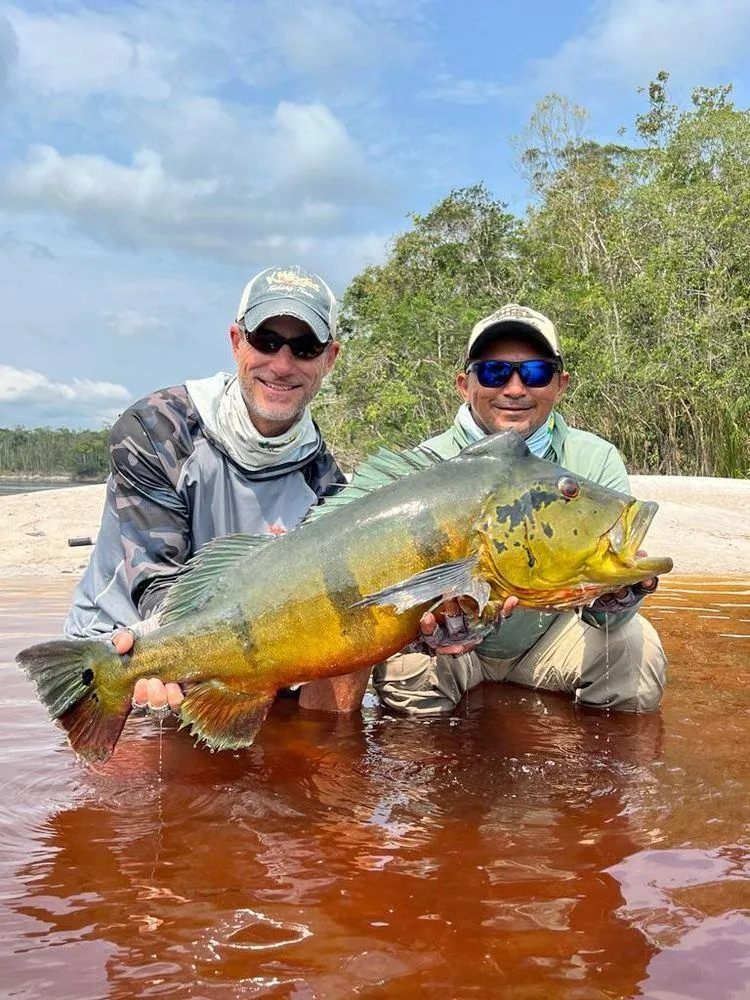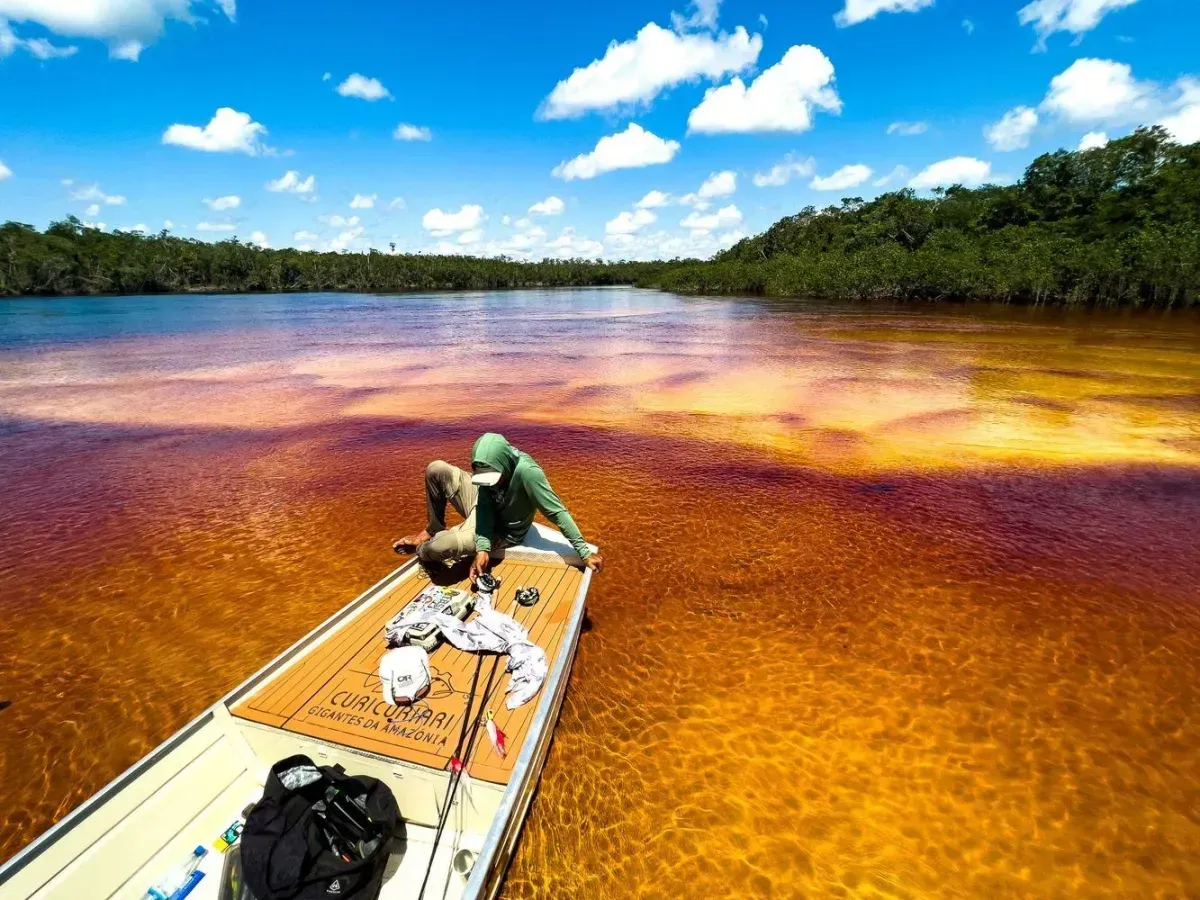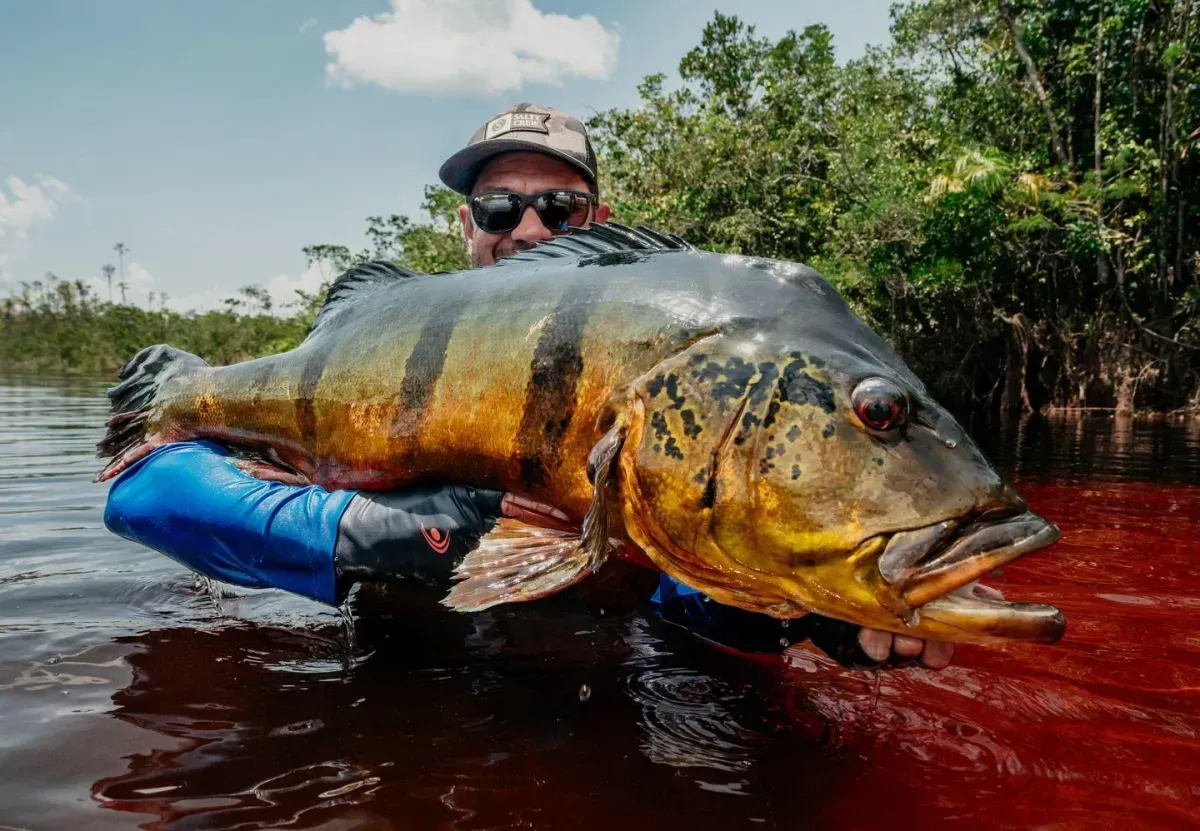Peacock Bass Fishing in the
Amazon Rainforest
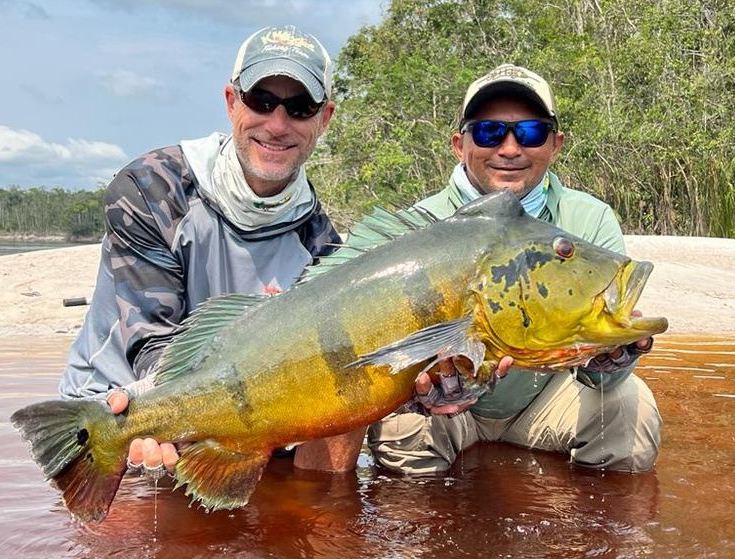
Explore South America's most thrilling freshwater fishery
Peacock bass are the most exciting gamefish in the Amazon—and among the most aggressive in the world. Found in the Rio Negro basin and its countless tributaries, these powerful cichlids are known for their explosive strikes, stunning colors, and relentless fights.
The largest of the species, the Temensis, dominates these Rio Negro waters, and two smaller species of Peacock Bass, the Orinocensis and Monoculus, add to the fun and variety of the Peacock Bass fishing.
Together, these three species dominate the region’s blackwater lagoons, hidden creeks, and flooded forests, creating a fishery unlike any other on Earth. Whether you're an experienced angler or new to jungle fishing, there’s no better place to chase action-packed days on the water than the Amazon.
Our Peacock Bass
Adventures at a Glance
Floating Bungalows
Mobility Meets Maximum Access
These fly-in, mobile floating cabins are designed to move with water levels, placing anglers directly in the most productive headwaters and hidden creeks in the Rio Negro tributaries. With just eight anglers per week, you’ll fish in secluded zones few others reach—catching both quantity and quality peacock bass in unpressured waters. Each bungalow features A/C, a private bathroom, and cozy beds for an immersive but comfortable jungle experience.
Floating Bungalows
This trip provides a great chance at large peacock bass in an intimate jungle setting. These floating bungalows can take you to the most inaccessible headwaters regions.
Remote Waters, Refined Experience
Blackwater EXPLORER
Remote Waters, Refined Experience
The most consistent fishing trip in the Amazon! This beautiful yacht roams the enormous Rio Negro basin from mid-October through February, concentrating on accessing productive waters.
With hundreds of miles of complex, island-dotted archipelagos and dozens of fish-laden tributaries, this is the world's largest peacock bass fishery – and the Explorer is built to take advantage of it.
Floating Bungalows
This trip provides a great chance at large peacock bass in an intimate jungle setting. These floating bungalows can take you to the most inaccessible headwaters regions.
Blackwater EXPLORER
Remote Waters, Refined Experience
The most consistent fishing trip in the Amazon! This beautiful yacht roams the enormous Rio Negro basin from mid-October through February, concentrating on accessing productive waters.
With hundreds of miles of complex, island-dotted archipelagos and dozens of fish-laden tributaries, this is the world's largest peacock bass fishery – and the Explorer is built to take advantage of it.
Curicuriari
Trophy Class Peacock Bass
This remote location on the Curicuriari River is a lightly fished tributary with a growing reputation for producing some of the biggest peacock bass in the Amazon. If you’re aiming for a peacock bass world record or a shot at your personal best, this is the place. Anglers often encounter Cichla temensis over 20 pounds in these secluded waters. You’ll stay in a boutique setting with air-conditioned suites, excellent food, and a serious focus on trophy fish.
Despite their name, peacock bass aren’t bass at all—they’re part of the cichlid family, known for their strength, speed, and territorial aggression. They display an astonishing range of color and pattern variations, from deep vertical bars to vibrant red fins and glowing gold flanks. And while their beauty is remarkable, it’s their behavior that truly sets them apart. These fish will smash topwater lures without hesitation, erupt from the water in wild leaps, and challenge even the best anglers to land them. It’s no exaggeration to say that every cast in these waters can lead to a memorable fight.
Acute Angling’s trips are strategically timed to fish the Rio Negro basin and the Curicuriari River during low-water conditions—when peacock bass are most concentrated and active. This seasonal pattern is the key to success. When the water drops and baitfish leave the flooded forest, peacock bass follow them into fishable lagoons and channels. That’s when we move in. Our deep knowledge of Amazon water cycles, along with mobile fishing platforms, lets us stay on productive waters while others are left behind. Whether you're after sheer numbers, solid quality, or the possibility of connecting with a fish of a lifetime, Acute Angling puts you in the best position to succeed.
These are dedicated peacock bass fishing trips, focused on high-action. We provide the conventional tackle, the guides, the logistics, and the accommodations—all you have to do is show up ready to fish. Whether you’re drawn to the fast-paced action of dozens of hard-fighting fish per day, or you’re hoping to land a record peacock bass, Acute Angling has the Amazon experience that fits your goals. With our long track record of excellence, high return-angler rate, and deep regional expertise, we offer the most complete way to fish peacock bass in South America.
TESTIMONIALS
What others are saying
"There is not a better outfit to go peacock bass fishing with than Acute Angling. They are first class all the way. From start to finish they take great care of you and leave nothing to chance…My expectations for this trip were high and they exceeded that. I guess the best compliment I can give them is I’ve already booked two future trips with them."
- Ashley P.

"The guides and all of the Acute Angling staff are the best. Peacock Bass are in a league of their own! If this is on your check-list, JUST DO IT, you will not be disappointed!"
- T.

“This was one of the best trips I’ve ever been on!...The management made the whole process very easy and provided a ton of info for us leading up to the trip. I honestly can’t rave enough about it. My dad already has another trip booked with them and I will definitely be booking with them in the future on one of their other trips as well. 10/10 experience.”
- Bannon G.

Join Us: Get monthly newsletters, discount offers and new content notifications exclusively for our members. Join for FREE below with your name and email.
Join Us: Get monthly newsletters, discount offers and new content notifications exclusively for our members. Join for FREE below with your name and email.
Read Our Newest Blogs
Lorem ipsum dolor sit amet, consectetur adipiscing elit. Aliquam

Amazon Rivers: Black, Blue, and White
The Amazon Basin is a vast waterway system. No two rivers are the same, but rivers are generally classified into three major buckets due to their color. Let’s look at these classifications and what causes the color variations.
BLACK WATER RIVERS:

Black Water and beautiful beaches make up the Rio Negro, the largest Black water river.
The most visited type of river by anglers due to it being the home of the largest species of peacock bass the Cichla, Temensis. Blackwater rivers are often described as a tea coloration.
A common question is what causes the tea coloration? To answer this question please see the explanation from the book The Amazon: What Everyone Needs to Know.
Blackwater rivers represent a freshwater tea created when plant matter that has fallen or washed into the river fails to completely decompose. The sandy soils surrounding blackwater rivers support few microorganisms that would otherwise decompose the leaf litter remnants, and the high concentrations of tannins and other plant compounds remain suspended in these rivers, giving them their characteristics color and making them highly acidic. (1)
Another valuable explanation comes from the book. Floods of Fortune: Ecology & Economy Along the Amazon.
Blackwater rivers, which are free of heavy sediment but dark in color. They owe their special character to the millions of years of erosion that have ground down the Brazilian and Guiana highlands into sands that now fill the Amazon Basin. Because millions of years of weathering, the sandy soils are very poor in nutrients. The streams that are born on them are among the most chemically pure on Earth. Why, then, the blackness?
It turns out that the sandy soils are too poor in microorganisms (especially fungi, bacteria, and invertebrates) to easily decompose organic matter. Organic chemicals, moreover, that would easily bind to clay sediments have no affinity for sand. The organic overload thus seeps through the soil and is carried into streams and rivers, rendering some as dark as tea. Blackwater rivers are highly acidic, with a pH usually below 4.0. (2)
To clarify, this doesn’t mean that Blackwater rivers are low in aquatic life. Peacock bass must have a stable and abundant food source to grow to the size that they do.
The lower Rio Negro harbors the most diverse fish fauna of any freshwater river in the world, having twice as many species (700) as all the rivers of western Europe combined. Most of these species are relatively small in size.” (1)
BLUE (OR CLEAR) WATER RIVERS:

Wolfish below a small rapid in a Clearwater Amazon River.
Blue water rivers are often clear and beautiful.
Rivers and streams that drain uplands to the east of the Andes are usually clear or almost so. These waterways arise in the old, worn-away mountains of the Brazilian Highlands to the south and the Guiana Highlands to the north. Chemically these clear water rivers range from acidic to nearly alkaline, but in general they are relatively nutrient-poor. The three largest clearwater rivers are the Rio Tapajos, Rio Xingu, and Rio Tocantins. All drain the Brazilian Highlands and enter the Amazon River from the south. (2)
Just as Rocky Mountain streams are effected by annual snow melt runoff, peak times during the rainy season can make these clear water streams temporarily off colored. For that reason, we generally do not fish during peak flows.
At the multi-species destination, the Rio Aripuanã, the river is clear and anglers can often spot fish while floating down the river. This makes for visual and exciting sport fishing opportunities.
WHITE WATER RIVERS

Rio Madeira
These White Water Rivers are not referring to rivers for paddle sports. These rivers have a high sediment load and are often a milky, coffee color. The Rio Solimoes which by many is considered the beginning of the Amazon River is a White Water River.
Amazonian whitewater rivers-despite the name-are more of a café-au-lait muddy brown than white. The color is due to sediments derived from the Andes.
These muddy rivers begin as clearwater streams in the Eastern Andes, where they start their descent into the Amazonian lowlands, gathering sediment along the way. As such, in the words of Michael Goulding, “the Andes are the main nutrient bank for the Amazon.” And the main body of the mighty Amazon-called the Rio Solimoes in Brazil-is a whitewater river. (1)
If you would like to see a map of the Amazon Basin distinguishing the major rivers by their river type, then please see the link below and scroll to the 4th page:
Resources:
The Amazon: What Everyone Needs to Know. Mark J. Plotkin. Page 38,39.
Flood of Fortune. Ecology & Economy Along The Amazon. Michael Guilding, Nigel J.H. Smith, and Dennis J. Mahar. Page 5, 6,7
A Classification of Major Naturally-Occuring Amazonian Lowland Wetlands. Multiple Authors. See page 3 for map.

(866) 832-2987

